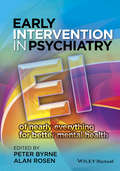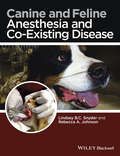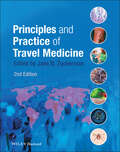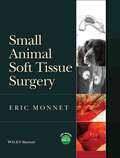- Table View
- List View
Early Intervention in Psychiatry: EI of Nearly Everything for Better Mental Health
by Peter Byrne Alan RosenEarly intervention (EI) is the single most important advance in mental health care in recent decades, representing a key shift in both theoretical standpoint and service delivery.Early Intervention in Psychiatry clearly describes best practice for extending this approach to all psychiatric disorders. Beginning with the rationale for EI, it informs interventions in people from all age groups across the lifespan, from perinatal to old age. It addresses EI in specific settings, such as primary health care, community health, the general hospital, non-government agencies, and in social movements, and for specific disorders including depression and anxiety, alcohol and substance use, childhood disorders, psychoses, bipolar disorders, eating disorders and borderline personality disorders.Early Intervention in Psychiatry is an essential guide for all psychiatrists, general practitioners, family physicians and public health doctors. It is also a valuable resource for mental health professionals and primary care colleagues, including nurses, social workers, psychologists, occupational therapists, vocational rehabilitation specialists, peer and support workers and for mental health commissioners and policy-makers.
Early Intervention in Psychiatry: EI of Nearly Everything for Better Mental Health
by Peter Byrne Alan RosenEarly intervention (EI) is the single most important advance in mental health care in recent decades, representing a key shift in both theoretical standpoint and service delivery.Early Intervention in Psychiatry clearly describes best practice for extending this approach to all psychiatric disorders. Beginning with the rationale for EI, it informs interventions in people from all age groups across the lifespan, from perinatal to old age. It addresses EI in specific settings, such as primary health care, community health, the general hospital, non-government agencies, and in social movements, and for specific disorders including depression and anxiety, alcohol and substance use, childhood disorders, psychoses, bipolar disorders, eating disorders and borderline personality disorders.Early Intervention in Psychiatry is an essential guide for all psychiatrists, general practitioners, family physicians and public health doctors. It is also a valuable resource for mental health professionals and primary care colleagues, including nurses, social workers, psychologists, occupational therapists, vocational rehabilitation specialists, peer and support workers and for mental health commissioners and policy-makers.
Epilepsy in Children and Adolescents
by James W. WhelessEpilepsy in childhood presents a profound challenge Epilepsy is an unsettling, complex condition. There is no ‘one size fits all’ option. For effective treatment a full understanding of each patient’s situation and clinical history is needed. Recent remarkable improvements in our ability to image brain structures, to define physiological patterns and in treatment options has made the task of care of the child with epilepsy potentially more effective. Epilepsy in Children and Adolescents provides the contemporary, caring guidance you need to diagnose and manage seizures in a young patient. Beginning with an overview of the classification of epilepsy syndromes, the experienced authors cover: Diagnostic evaluation of childhood epilepsies Principles of treatment Generalized seizures and generalized epilepsy syndromes Partial onset seizures and localization-related epilepsy syndromes Epilepsies relative to age, etiology or duration The full range of treatment options: medical, dietary, surgical Epilepsy in Children and Adolescents takes a practical approach to a common but complex clinical challenge.
Partnering for Recovery in Mental Health: A Practical Guide to Person-Centered Planning
by Janis Tondora Rebecca Miller Mike Slade Larry DavidsonPartnering for Recovery in Mental Health is a practical guide for conducting person and family-centered recovery planning with individuals with serious mental illnesses and their families. It is derived from the authors’ extensive experience in articulating and implementing recovery-oriented practice and has been tested with roughly 3,000 providers who work in the field as well as with numerous post-graduate trainees in psychology, social work, nursing, and psychiatric rehabilitation. It has consistently received highly favorable evaluations from health care professionals as well as people in recovery from mental illness. This guide represents a new clinical approach to the planning and delivery of mental health care. It emerges from the mental health recovery movement, and has been developed in the process of the efforts to transform systems of care at the local, regional, and national levels to a recovery orientation. It will be an extremely useful tool for planning care within the context of current health care reform efforts and increasingly useful in the future, as systems of care become more person-centered. Consistent with other patient-centered care planning approaches, this book adapts this process specifically to meet the needs of persons with serious mental illnesses and their families. Partnering for Recovery in Mental Health is an invaluable guide for any person involved directly or indirectly in the provision, monitoring, evaluation, or use of community-based mental health care.
Partnering for Recovery in Mental Health: A Practical Guide to Person-Centered Planning
by Janis Tondora Rebecca Miller Mike Slade Larry DavidsonPartnering for Recovery in Mental Health is a practical guide for conducting person and family-centered recovery planning with individuals with serious mental illnesses and their families. It is derived from the authors’ extensive experience in articulating and implementing recovery-oriented practice and has been tested with roughly 3,000 providers who work in the field as well as with numerous post-graduate trainees in psychology, social work, nursing, and psychiatric rehabilitation. It has consistently received highly favorable evaluations from health care professionals as well as people in recovery from mental illness. This guide represents a new clinical approach to the planning and delivery of mental health care. It emerges from the mental health recovery movement, and has been developed in the process of the efforts to transform systems of care at the local, regional, and national levels to a recovery orientation. It will be an extremely useful tool for planning care within the context of current health care reform efforts and increasingly useful in the future, as systems of care become more person-centered. Consistent with other patient-centered care planning approaches, this book adapts this process specifically to meet the needs of persons with serious mental illnesses and their families. Partnering for Recovery in Mental Health is an invaluable guide for any person involved directly or indirectly in the provision, monitoring, evaluation, or use of community-based mental health care.
Histologic Basis of Ocular Disease in Animals
by Bruce Grahn Robert Peiffer Brian WilcockHistologic Basis of Ocular Disease in Animals is a comprehensive reference covering pathology of the eye in a spectrum of animal species, including domestic animals, fish, birds, and laboratory animals. Offers a comprehensive resource on diseases and conditions of the eye and orbit in a wide range of species Covers domestic animals, fish, birds, and laboratory animals Presents more than 1200 high-quality images carefully selected to illustrate the ocular conditions covered Emphasizes unique pathological responses where necessary
Histologic Basis of Ocular Disease in Animals
by Bruce Grahn Robert Peiffer Brian WilcockHistologic Basis of Ocular Disease in Animals is a comprehensive reference covering pathology of the eye in a spectrum of animal species, including domestic animals, fish, birds, and laboratory animals. Offers a comprehensive resource on diseases and conditions of the eye and orbit in a wide range of species Covers domestic animals, fish, birds, and laboratory animals Presents more than 1200 high-quality images carefully selected to illustrate the ocular conditions covered Emphasizes unique pathological responses where necessary
Canine and Feline Anesthesia and Co-Existing Disease
by Lindsey B. C. Snyder Rebecca A. JohnsonCanine and Feline Anesthesia and Co-Existing Disease is the first book to draw together clinically relevant information on the anesthetic management of dogs and cats with existing disease conditions. Providing a detailed reference on avoiding and managing complications resulting from concurrent disease, the book offers a ready reference for handling anesthesia in patients with common presenting diseases. Organized by body system, Canine and Feline Anesthesia and Co-Existing Disease is designed to allow the reader to quickly find and apply advice for anesthetizing patients with specific conditions. Each chapter presents in-depth, practical information on the special considerations before, during, and after sedation and anesthesia of a patient with a given disease. Canine and Feline Anesthesia and Co-Existing Disease is a useful reference for general practitioners, veterinary students, specialists in a variety of areas, and veterinary anesthesiologists alike.
Canine and Feline Anesthesia and Co-Existing Disease
by Lindsey B.C. Snyder Rebecca A. JohnsonCanine and Feline Anesthesia and Co-Existing Disease is the first book to draw together clinically relevant information on the anesthetic management of dogs and cats with existing disease conditions. Providing a detailed reference on avoiding and managing complications resulting from concurrent disease, the book offers a ready reference for handling anesthesia in patients with common presenting diseases. Organized by body system, Canine and Feline Anesthesia and Co-Existing Disease is designed to allow the reader to quickly find and apply advice for anesthetizing patients with specific conditions. Each chapter presents in-depth, practical information on the special considerations before, during, and after sedation and anesthesia of a patient with a given disease. Canine and Feline Anesthesia and Co-Existing Disease is a useful reference for general practitioners, veterinary students, specialists in a variety of areas, and veterinary anesthesiologists alike.
Transplant Administration
by Lisa NorrisThis timely new book, written by a transplant administrator with over sixteen years of experience, along with other expert contributors, covers the specifics of each aspect of transplant administration, providing information that will enable new administrators to quickly master essentials, help more seasoned administrators evaluate and improve their programs, and generally provide a knowledge base, focused on best-practices in light of regulatory requirements, for transplant surgeons, aspirant administrators and hospital administrators. Comprehensively covers all aspects of transplant program administration, including management, finance, staffing, quality improvement, patient intake, communication and collaboration with clinical staff, and more. Emphasizes practical application of best practices; uses bullet lists and other features to highlight essential information for each topic covered. Accompanying "Toolkit", available via the book's companion website, provides forms, a procedural manual, program assessment materials and more which buyers can use "out of the box" or adapt for use in their own program. While the book and its supplemental materials have been created specifically with the US transplant community in mind, they still have considerable value for transplant administrators and related professionals outside the US, for instance, transplantation and health policy researchers, hospital management staff who are tasked with starting a transplant program from scratch and who need ready-made materials they can adapt to suit their own regulatory environment, and others.
Transplant Administration
by Lisa NorrisThis timely new book, written by a transplant administrator with over sixteen years of experience, along with other expert contributors, covers the specifics of each aspect of transplant administration, providing information that will enable new administrators to quickly master essentials, help more seasoned administrators evaluate and improve their programs, and generally provide a knowledge base, focused on best-practices in light of regulatory requirements, for transplant surgeons, aspirant administrators and hospital administrators. Comprehensively covers all aspects of transplant program administration, including management, finance, staffing, quality improvement, patient intake, communication and collaboration with clinical staff, and more. Emphasizes practical application of best practices; uses bullet lists and other features to highlight essential information for each topic covered. Accompanying "Toolkit", available via the book's companion website, provides forms, a procedural manual, program assessment materials and more which buyers can use "out of the box" or adapt for use in their own program. While the book and its supplemental materials have been created specifically with the US transplant community in mind, they still have considerable value for transplant administrators and related professionals outside the US, for instance, transplantation and health policy researchers, hospital management staff who are tasked with starting a transplant program from scratch and who need ready-made materials they can adapt to suit their own regulatory environment, and others.
Clinical Electrocardiography, Enhanced Edition: A Textbook
by Antoni Bayés de LunaWritten by one of the world's most respected cardiologists and designed with the needs of the internist and general clinical cardiologist in mind, this new volume provides clear, accessible guidance on the use of electrocardiography to diagnose and manage cardiovascular disease.
Principles and Practice of Travel Medicine
by Jane N. ZuckermanThis second edition of Principles and Practice of Travel Medicine has been extensively updated to provide a comprehensive description of travel medicine and is an invaluable reference resource to support the clinical practice of travel medicine. This new edition covers the many recent advances in the field, including the development of new and combined vaccines; malaria prophylaxis; emerging new infections; new hazards resulting from travel to long haul destinations; health tourism; and population movements. The chapter on vaccine-preventable diseases includes new developments in licensed vaccines, as well as continent-based recommendations for their administration. There are chapters on the travel health management of high risk travellers, including the diabetic traveller, the immuno-compromised, those with cardiovascular, renal, neurological, gastrointestinal, malignant and other disorders, psychological and psychiatric illnesses, pregnant women, children and the elderly. With increasing numbers of ever more adventurous travellers, there is discussion of travel medicine within extreme environments, whilst the chapter on space tourism may well be considered the future in travel medicine. Principles and Practice of Travel Medicine is an invaluable resource for health care professionals providing advice and clinical care to the traveller.
Principles and Practice of Travel Medicine
by Jane N. ZuckermanThis second edition of Principles and Practice of Travel Medicine has been extensively updated to provide a comprehensive description of travel medicine and is an invaluable reference resource to support the clinical practice of travel medicine. This new edition covers the many recent advances in the field, including the development of new and combined vaccines; malaria prophylaxis; emerging new infections; new hazards resulting from travel to long haul destinations; health tourism; and population movements. The chapter on vaccine-preventable diseases includes new developments in licensed vaccines, as well as continent-based recommendations for their administration. There are chapters on the travel health management of high risk travellers, including the diabetic traveller, the immuno-compromised, those with cardiovascular, renal, neurological, gastrointestinal, malignant and other disorders, psychological and psychiatric illnesses, pregnant women, children and the elderly. With increasing numbers of ever more adventurous travellers, there is discussion of travel medicine within extreme environments, whilst the chapter on space tourism may well be considered the future in travel medicine. Principles and Practice of Travel Medicine is an invaluable resource for health care professionals providing advice and clinical care to the traveller.
The Dentist's Drug and Prescription Guide
by Mea A. Weinberg Stuart J. FroumA Critical Resource with Information You Won't Find Anywhere Else. Dentists of all specialties prescribe drugs for their patients, from pain medications to sedatives to antibiotics, and know all too well that making an evidenced-based decision on which drug to prescribe is more than just looking up a drug on the computer or PDA and requires more comprehensive consideration than the current drug reference books offer. For example, should an antibiotic be prescribed for implant placement or for sinus augmentation procedures? If so, what antibiotic is recommended (backed up with references), when should it be started, and for how long? Which is the antibiotic of choice for an odontogenic infection and how do you know if that antibiotic is working? Improve Your Decision Making with this Essential Guide. The Dentist’s Drug and Prescription Guide is the only book to offer comprehensive coverage of this topic and has quickly become the go-to reference for dental students, general dentists, periodontists, oral surgeons, dental hygienists. Written for dental professionals seeking quick advice on prescribing medications for their patients, the book offers: An easy-to-read question-and-answer format, the text describes evidenced-based pharmacologic therapy with current and up-to-date references regarding adjunctive pharmacologic treatment of the dental patient Easy-to-follow drug tables that summarize the main pharmacologic features of the different disciplines, including periodontics, implantology, oral surgery, and endodontics, with recommendations for pharmacologic treatment with periodontal and implant surgery as well as treatment of periodontal diseases, dental pain, and infection Detailed strategies to manage and prevent drug interactions in the dental practice Instructions and guidelines for the patient on how to take the drugs (e.g., to avoid GI upset when taking antibiotics acidophilus or yogurt can be taken). Plus, sample prescriptions, coverage of proper documentation in the patient's chart, and more! Order your copy today!
The Dentist's Drug and Prescription Guide
by Mea A. Weinberg Stuart J. FroumA Critical Resource with Information You Won't Find Anywhere Else. Dentists of all specialties prescribe drugs for their patients, from pain medications to sedatives to antibiotics, and know all too well that making an evidenced-based decision on which drug to prescribe is more than just looking up a drug on the computer or PDA and requires more comprehensive consideration than the current drug reference books offer. For example, should an antibiotic be prescribed for implant placement or for sinus augmentation procedures? If so, what antibiotic is recommended (backed up with references), when should it be started, and for how long? Which is the antibiotic of choice for an odontogenic infection and how do you know if that antibiotic is working? Improve Your Decision Making with this Essential Guide. The Dentist’s Drug and Prescription Guide is the only book to offer comprehensive coverage of this topic and has quickly become the go-to reference for dental students, general dentists, periodontists, oral surgeons, dental hygienists. Written for dental professionals seeking quick advice on prescribing medications for their patients, the book offers: An easy-to-read question-and-answer format, the text describes evidenced-based pharmacologic therapy with current and up-to-date references regarding adjunctive pharmacologic treatment of the dental patient Easy-to-follow drug tables that summarize the main pharmacologic features of the different disciplines, including periodontics, implantology, oral surgery, and endodontics, with recommendations for pharmacologic treatment with periodontal and implant surgery as well as treatment of periodontal diseases, dental pain, and infection Detailed strategies to manage and prevent drug interactions in the dental practice Instructions and guidelines for the patient on how to take the drugs (e.g., to avoid GI upset when taking antibiotics acidophilus or yogurt can be taken). Plus, sample prescriptions, coverage of proper documentation in the patient's chart, and more! Order your copy today!
Small Animal Soft Tissue Surgery
by Eric MonnetSmall Animal Soft Tissue Surgery is a comprehensive, in-depth resource for well-referenced, current information on small animal soft tissue surgery. Offering detailed surgical techniques in a well-illustrated, easy-to-follow format, the book covers the full range of surgically treated diseases and syndromes, with video clips and slideshows to demonstrate surgical procedures on an accompanying DVD. Chapters are written by the leading experts in surgery, internal medicine, radiology, and critical care, presenting information based on a review of the most recent literature. Divided into chapters by body system, each section begins with a brief review of the anatomy and physiology, with pathophysiology, diagnosis, treatment, and prognosis described in detail. Original illustrations and clinical photographs accompany the description of surgical techniques, and an evidence-based approach is incorporated throughout. Small Animal Soft Tissue Surgery is an essential reference for small animal surgeons, residents, and practitioners performing soft tissue surgery. For e-book purchasers: DVD materials are not included as part of the e-book file, but are available for download after purchase.
Small Animal Soft Tissue Surgery
by Eric MonnetSmall Animal Soft Tissue Surgery is a comprehensive, in-depth resource for well-referenced, current information on small animal soft tissue surgery. Offering detailed surgical techniques in a well-illustrated, easy-to-follow format, the book covers the full range of surgically treated diseases and syndromes, with video clips and slideshows to demonstrate surgical procedures on an accompanying DVD. Chapters are written by the leading experts in surgery, internal medicine, radiology, and critical care, presenting information based on a review of the most recent literature. Divided into chapters by body system, each section begins with a brief review of the anatomy and physiology, with pathophysiology, diagnosis, treatment, and prognosis described in detail. Original illustrations and clinical photographs accompany the description of surgical techniques, and an evidence-based approach is incorporated throughout. Small Animal Soft Tissue Surgery is an essential reference for small animal surgeons, residents, and practitioners performing soft tissue surgery. For e-book purchasers: DVD materials are not included as part of the e-book file, but are available for download after purchase.
How to Succeed at the Medical Interview (How To #41)
by Chris Smith Darryl MeekingHow to Succeed at the Medical Interview provides candidates with a competitive edge. It reduces the likelihood of unexpected questions or situations and helps improve confidence before and during the medical interview. This new second edition includes updated content on changes to the structure of healthcare and how this affects both the application and interview process. It details the types of questions that will be asked at medical interviews and also provides improved guidance for overseas doctors and healthcare professionals and for those seeking to practice abroad. How to Succeed at the Medical Interview is the ideal guide for Foundation Programme trainees, Specialist Registrars and General Practitioner trainees. It is also valuable for healthcare professionals facing competitive medical interviews at any stage of their career.
How to Succeed at the Medical Interview (How To #42)
by Chris Smith Darryl MeekingHow to Succeed at the Medical Interview provides candidates with a competitive edge. It reduces the likelihood of unexpected questions or situations and helps improve confidence before and during the medical interview. This new second edition includes updated content on changes to the structure of healthcare and how this affects both the application and interview process. It details the types of questions that will be asked at medical interviews and also provides improved guidance for overseas doctors and healthcare professionals and for those seeking to practice abroad. How to Succeed at the Medical Interview is the ideal guide for Foundation Programme trainees, Specialist Registrars and General Practitioner trainees. It is also valuable for healthcare professionals facing competitive medical interviews at any stage of their career.
The Renal System at a Glance (At a Glance)
by Christopher O'CallaghanHighly Commended in Internal medicine in the 2017 BMA Medical Book AwardsThe Renal System at a Glance is a highly illustrated and practical guide to the structure and function of the kidney, renal, and urinary system. It also covers related disorders and abnormalities and their treatment. Fully updated to reflect the many exciting new developments in the understanding of nephrology, this new edition has been restructured to better integrate basic science and clinical examples to the medical school curricula. New chapters on glomerular filtration and global kidney medicine are included, while the latest guidance and approaches to acute kidney injury, chronic kidney diseases, and renal replacement therapy have also been incorporated. The Renal System at a Glance: Offers clear explanations on tricky topics such as electrolytes, fluid balance and acid-base handling Features new sections on glomerular filtration, and a new chapter on the global differences in kidney problems Includes cross-referencing between basic science and related clinical content Focuses on clinical disorders and investigations – ideal for those embarking on medicine rotations Illustrates each topic in a double page spread, complete with charts, graphs, and photographs An updated companion website is available at www.ataglanceseries.com/renalsystem featuring animations and MCQs This new edition is the perfect guide for medical students, junior doctors, and allied health professionals, including specialist nurses, who wish to learn, or refresh their knowledge, on the kidney and renal system in health and disease.
The Renal System at a Glance (At a Glance)
by Christopher O'CallaghanHighly Commended in Internal medicine in the 2017 BMA Medical Book AwardsThe Renal System at a Glance is a highly illustrated and practical guide to the structure and function of the kidney, renal, and urinary system. It also covers related disorders and abnormalities and their treatment. Fully updated to reflect the many exciting new developments in the understanding of nephrology, this new edition has been restructured to better integrate basic science and clinical examples to the medical school curricula. New chapters on glomerular filtration and global kidney medicine are included, while the latest guidance and approaches to acute kidney injury, chronic kidney diseases, and renal replacement therapy have also been incorporated. The Renal System at a Glance: Offers clear explanations on tricky topics such as electrolytes, fluid balance and acid-base handling Features new sections on glomerular filtration, and a new chapter on the global differences in kidney problems Includes cross-referencing between basic science and related clinical content Focuses on clinical disorders and investigations – ideal for those embarking on medicine rotations Illustrates each topic in a double page spread, complete with charts, graphs, and photographs An updated companion website is available at www.ataglanceseries.com/renalsystem featuring animations and MCQs This new edition is the perfect guide for medical students, junior doctors, and allied health professionals, including specialist nurses, who wish to learn, or refresh their knowledge, on the kidney and renal system in health and disease.
The Student Nurse Toolkit: An Essential Guide for Surviving Your Course
by Professor Ian Peate OBEYour very own companion to any pre-registration nursing course! Packed with advice, hints and tips, this essential, practical guide will orientate and guide you through your nursing course even before you start. Written in a straightforward, no-nonsense style, this Toolkit is full of strategies and help for surviving and succeeding on your pre-registration nursing course, and addresses all the key issues and concerns you may face, including: How to get the most out of your clinical placement The nursing terminology you need to know – including NMC standards How to create a professional Portfolio How to achieve a healthy work-life balance How to develop an effective relationship with your mentor With case studies from real students, hands-on activities and suggestions for further reading, this is THE essential survival guide for your nursing course!
The Student Nurse Toolkit: An Essential Guide for Surviving Your Course
by Professor Ian Peate OBEYour very own companion to any pre-registration nursing course! Packed with advice, hints and tips, this essential, practical guide will orientate and guide you through your nursing course even before you start. Written in a straightforward, no-nonsense style, this Toolkit is full of strategies and help for surviving and succeeding on your pre-registration nursing course, and addresses all the key issues and concerns you may face, including: How to get the most out of your clinical placement The nursing terminology you need to know – including NMC standards How to create a professional Portfolio How to achieve a healthy work-life balance How to develop an effective relationship with your mentor With case studies from real students, hands-on activities and suggestions for further reading, this is THE essential survival guide for your nursing course!
History of Cognitive Neuroscience
by M. R. Bennett P. M. HackerHistory of Cognitive Neuroscience documents the major neuroscientific experiments and theories over the last century and a half in the domain of cognitive neuroscience, and evaluates the cogency of the conclusions that have been drawn from them. Provides a companion work to the highly acclaimed Philosophical Foundations of Neuroscience - combining scientific detail with philosophical insights Views the evolution of brain science through the lens of its principal figures and experiments Addresses philosophical criticism of Bennett and Hacker's previous book Accompanied by more than 100 illustrations













